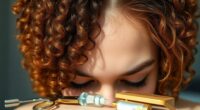Yes, glycolic acid can help with hair growth! It exfoliates your scalp, removes dead skin cells, and clears product build-up, creating a healthier environment for hair follicles. This alpha hydroxy acid also balances pH levels, boosting moisture retention and reducing breakage. However, it's important to use it properly and be aware of potential risks. Want to explore the best ways to maximize its benefits and understand proper usage? Keep going to find out more!
Key Takeaways
- Glycolic acid exfoliates the scalp, removing dead skin cells and product build-up, creating a healthier environment for hair growth.
- It helps unclog hair follicles, which can stimulate new hair growth and reduce breakage.
- The acid balances scalp pH levels, enhancing moisture retention and promoting overall scalp health.
- Glycolic acid has anti-inflammatory properties that can soothe irritated scalps, particularly beneficial for conditions like dandruff.
- Regular use (once or twice a week) can improve scalp conditions, contributing to healthier hair growth over time.
What Is Glycolic Acid and Its Role in Hair Health?
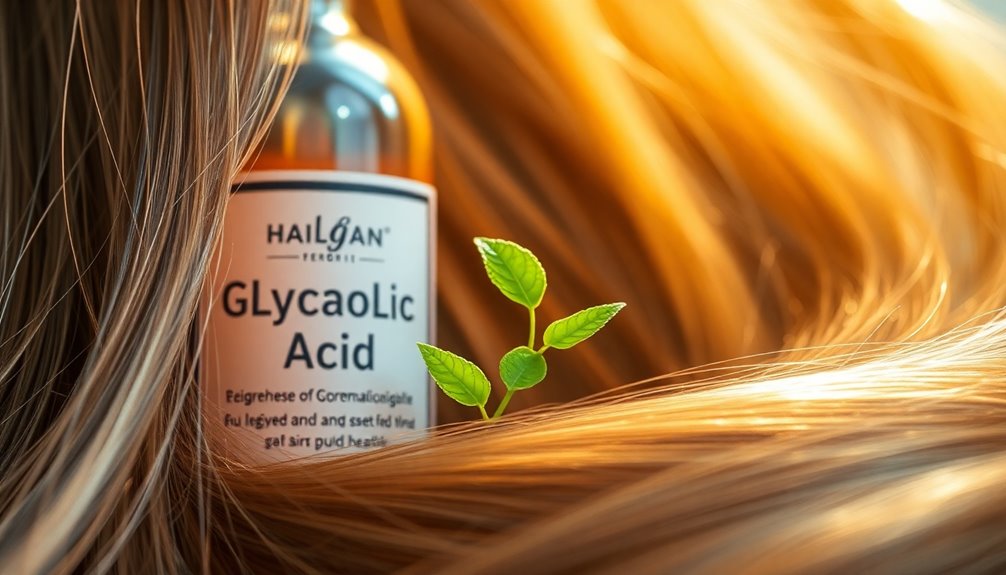
Glycolic acid, a powerful alpha hydroxy acid derived from sugar cane, plays an essential role in maintaining hair health.
Glycolic acid, a potent ingredient from sugar cane, is essential for vibrant and healthy hair.
It effectively exfoliates the scalp, removing dead skin cells and product build-up that can clog hair follicles. By doing this, glycolic acid creates a healthier environment that promotes hair growth and reduces breakage. Its ability to balance pH levels on the scalp prevents irritation from alkaline shampoos and enhances moisture retention in your hair.
Additionally, glycolic acid's anti-inflammatory properties help reduce scalp inflammation, contributing to an improved overall scalp condition. Moreover, it aids in improving absorption of topical treatments for hair, maximizing the effectiveness of your hair care products. Regular use of glycolic acid can also enhance scalp health by promoting clearer, more radiant skin on the scalp.
For ideal results, consider applying glycolic acid products once or twice a week to maximize benefits without causing irritation.
Embracing this ingredient can truly transform your hair care routine.
Benefits of Glycolic Acid for Scalp and Hair Growth

When you incorporate glycolic acid into your hair care routine, you'll reveal a range of benefits that can greatly enhance both scalp health and hair growth.
Here's how glycolic acid works wonders for you:
- Exfoliates: It removes dead skin cells and product build-up, unclogging hair follicles for healthier scalp conditions.
- Balances pH: By preventing hair shaft swelling, it improves overall hair health.
- Reduces Inflammation: Its antibacterial properties help minimize scalp acne and inflammation, promoting smoother hair growth.
- Enhances Moisture Retention: Regular use boosts moisture levels, reducing stiffness and breakage, leading to stronger hair growth.
Additionally, maintaining a well-hydrated scalp is essential for skin health and can further support optimal hair growth.
With these benefits, glycolic acid truly creates a healthier scalp environment, potentially stimulating new hair growth over time.
How to Properly Use Glycolic Acid on Your Scalp

To get the best results from glycolic acid on your scalp, start by choosing a product with the right concentration and pH. When applying it, make sure your scalp is clean and dry, and don't forget to massage it in gently. Glycolic acid can also improve skin texture on the scalp, which may enhance the overall health of your hair follicles. Finally, stick to using it just once or twice a week to keep your scalp healthy and avoid irritation. Additionally, be aware of essential oil safety when combining treatments to prevent any adverse reactions on sensitive skin.
Choosing the Right Product
Choosing the right glycolic acid product is crucial for effective scalp care. To maximize benefits while minimizing scalp irritation, follow these guidelines:
- Concentrations: Look for glycolic acid concentrations between 5% to 10% for effective exfoliation.
- Application: Apply the product directly onto your scalp using a serum or toner, massaging gently. Regular use of essential oils can also enhance scalp health and promote hair growth.
- Timing: Leave the glycolic acid on for 10 to 30 minutes as a pre-shampoo treatment.
- Frequency: Limit use to once or twice a week to prevent scalp damage.
Additionally, always conduct a patch test before trying a new product to guarantee you don't have any allergic reactions or sensitivities. This approach helps you achieve peak results while taking care of your scalp. Incorporating nutrient-rich foods into your diet, such as leafy greens, can further support scalp health and hair growth.
Application Techniques
Applying glycolic acid correctly can greatly enhance its benefits for your scalp. Start by using a serum or toner designed for scalp application. Gently massage it into your dry scalp, focusing on areas with product build-up. Let it sit for 10 to 30 minutes to exfoliate dead skin cells and promote hair growth. Incorporating essential oils like rosemary oil, known for stimulating blood circulation, can further support hair follicle health. Rinse thoroughly with a moisturizing shampoo and conditioner to remove any residue and hydrate your scalp. Additionally, utilizing high-quality equipment can play a significant role in enhancing the overall health of your hair and scalp.
| Step | Details |
|---|---|
| Product | Use a glycolic acid serum or toner |
| Application | Massage gently into dry scalp |
| Rinse | Use a moisturizing shampoo and conditioner |
Limit your treatments to once or twice a week to avoid irritation and dryness, especially if you have a sensitive scalp.
Recommended Frequency of Use
Using glycolic acid on your scalp once or twice a week is ideal for maximizing its benefits while minimizing irritation.
Here's how to properly incorporate it into your routine:
- Patch Test: Always perform a patch test before use to check for sensitivity.
- Application: Apply glycolic acid directly to dry hair, ensuring even coverage for effective exfoliation.
- Timing: Leave it on your scalp for 10 to 30 minutes to allow for absorption.
- Rinse: Use a moisturizing shampoo and conditioner to rinse out the product.
Stick to a concentration of 5-10% for safety, as higher levels can cause irritation or damage. This recommended frequency will support scalp health and promote hair growth effectively. Additionally, utilizing personalized learning pathways can enhance your understanding of effective hair care practices tailored to your needs.
Potential Risks and Precautions When Using Glycolic Acid

While glycolic acid can offer benefits for hair growth, it's important to be aware of its potential risks and precautions.
Using glycolic acid in high concentrations can lead to scalp irritation, especially if you have sensitive skin. Always perform patch testing before applying it more broadly to avoid allergic reactions, which can include redness and itchiness.
Overuse may also increase UV sensitivity, raising your risk of sunburn. To minimize the chances of chemical burns and contact dermatitis, limit your usage to once or twice a week. This helps prevent overdrying, which could potentially lead to further hair loss.
Alternatives to Glycolic Acid for Hair Loss Treatment
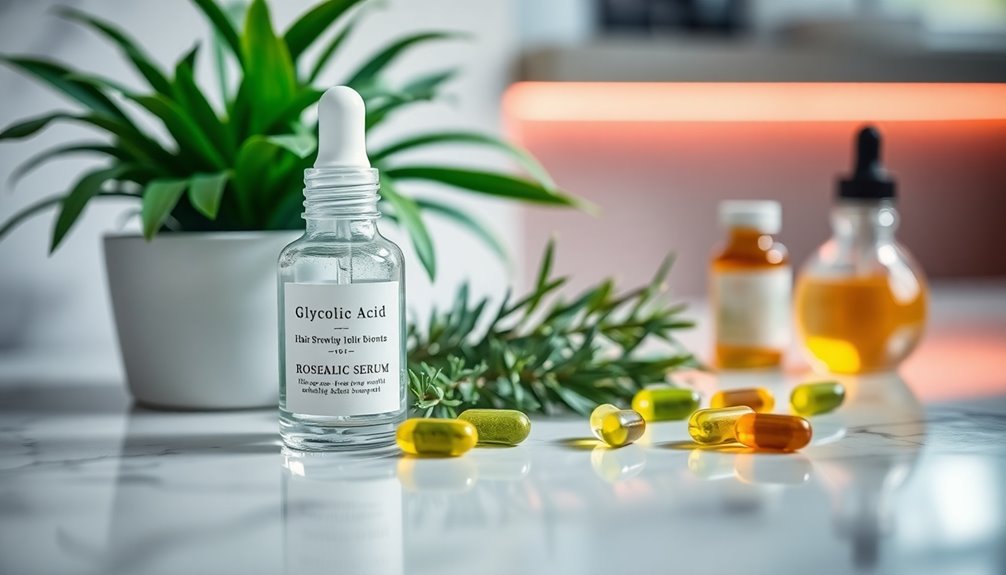
For those seeking alternatives to glycolic acid in the quest for hair loss treatment, several options can effectively promote hair growth without the associated risks.
Consider these alternatives:
Explore effective alternatives to glycolic acid for hair loss treatment that promote growth and address underlying issues.
- Minoxidil: This topical treatment stimulates hair follicles, showing up to a 60% improvement in hair density.
- Finasteride: Effective for male pattern baldness, though not recommended for premenopausal women due to hormonal side effects.
- Steroid creams: These can reduce inflammation and support hair restoration, especially in conditions like alopecia areata.
- Anti-fungal shampoos: Formulations containing ketoconazole and zinc pyrithione can manage scalp conditions like seborrheic dermatitis, promoting healthier hair growth.
These treatments offer various pathways to combat hair loss while addressing underlying issues.
Understanding Hair Loss: Causes and Solutions
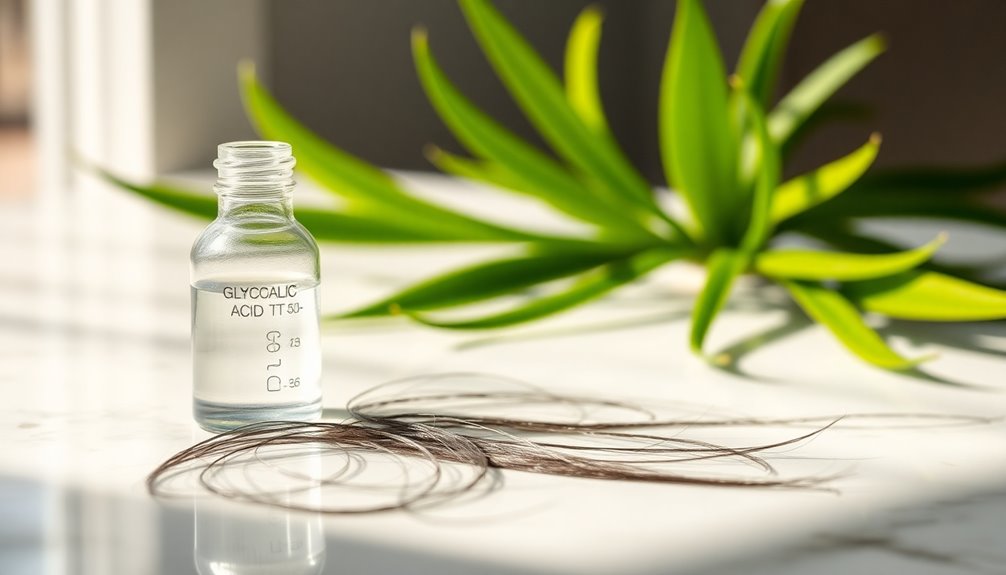
Hair loss can stem from various factors, like genetics, hormones, and stress, so it's crucial to understand what's causing your issue.
Early diagnosis can make a big difference, as many types of hair loss are treatable.
Common Hair Loss Causes
Understanding the causes of hair loss is essential, especially since various factors can contribute to this common issue.
Here are four common hair loss causes you should know:
- Androgenetic alopecia: This genetic condition affects about 50% of people by age 50, causing gradual thinning.
- Telogen effluvium: Triggered by stress, hormonal changes, or nutritional deficiencies, this temporary condition leads to increased hair shedding.
- Alopecia areata: An autoimmune disorder that causes sudden patchy hair loss, impacting around 2% of the population.
- Traction alopecia: Resulting from tight hairstyles, if not addressed, this can lead to permanent loss.
Addressing these issues early can help maintain a healthy scalp and support effective hair growth with the right hair care products.
Effective Treatment Options
While various factors contribute to hair loss, effective treatment options can make a significant difference in regaining your hair's health. One promising approach is using glycolic acid, which helps exfoliate the scalp by removing dead skin cells. This creates a healthier environment for hair growth.
Topical treatments like minoxidil, FDA-approved for both men and women, can stimulate hair follicles directly. For men, finasteride may be an option, though it's not recommended for premenopausal women.
Additionally, using anti-fungal shampoos with ketoconazole and zinc pyrithione can address scalp issues and promote overall scalp health. By exploring these treatment options, you can tackle hair loss effectively and boost your confidence in the process.
Importance of Early Diagnosis
Recognizing hair loss early can make an essential difference in your journey toward recovery.
Timely diagnosis allows for more effective treatment options, maximizing your chances of reversing hair loss.
Here are a few reasons why early diagnosis matters:
- Identifies underlying causes such as hormonal changes or stress.
- Enables tailored treatments through consultation with a trichologist or dermatologist.
- Offers non-invasive treatments like topical solutions or lifestyle changes before considering hair transplants.
- Improves recovery rates, with statistics showing hair transplant success rates of 97-100% when addressing advanced hair loss.
Expert Recommendations for Healthy Hair Growth
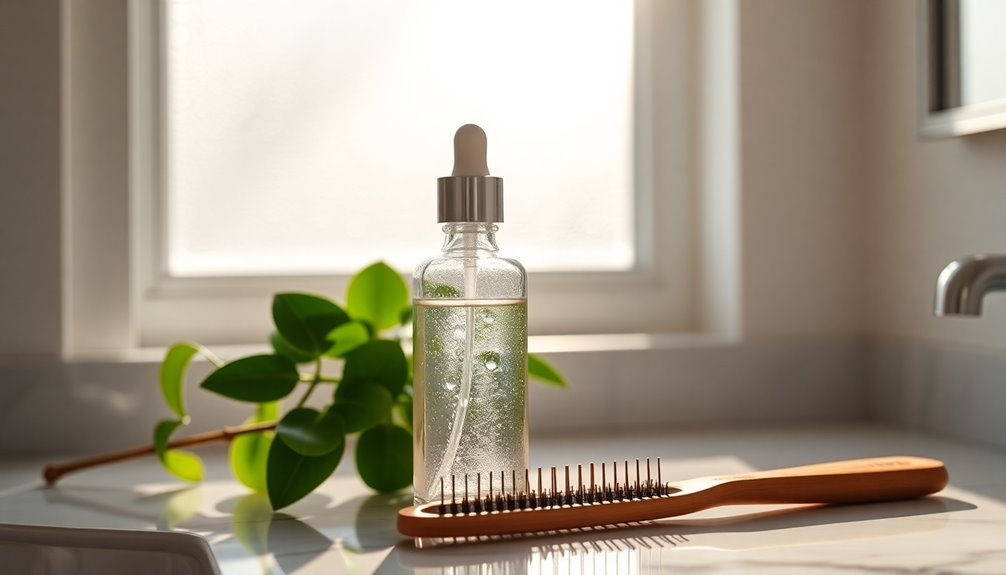
To achieve healthy hair growth, experts recommend incorporating glycolic acid into your scalp care routine. This powerful ingredient helps exfoliate the scalp, removing dead skin cells that can clog hair follicles and impede hair growth.
Regular use of glycolic acid, at concentrations of 5-10%, can enhance moisture retention, preventing dryness and breakage while promoting hair health. It's best to apply it once or twice a week, letting it sit for 10-30 minutes before rinsing.
Additionally, its anti-inflammatory properties can soothe irritated scalps, creating a healthier environment for hair growth. Glycolic acid may be especially beneficial for those with oily scalps or conditions like dandruff, which often hinder hair growth.
Frequently Asked Questions
Does Glycolic Acid Make Hair Grow Faster?
Glycolic acid doesn't directly make your hair grow faster, but it can improve your scalp's health.
By exfoliating and removing dead skin cells, it helps unclog hair follicles, which may create a better environment for hair growth.
Its anti-inflammatory properties and ability to balance pH can also protect your hair from damage.
While it enhances the effectiveness of nourishing products, it's important to remember that results can vary from person to person.
How Often Should I Use Glycolic Acid on My Hair?
Think of your scalp as a garden; it needs care to thrive.
You should use glycolic acid on your hair and scalp once or twice a week. Start with a lower concentration of 5-10% to see how your scalp reacts.
Let it sit for 10-30 minutes before rinsing it out. Remember, moderation is key—overusing it can dry out your scalp, so stick to the recommended frequency for best results.
Can I Use the Ordinary Glycolic Acid on My Scalp?
Yes, you can use The Ordinary Glycolic Acid on your scalp. Just apply it directly to dry hair and leave it on for 10-20 minutes before rinsing.
This toner helps exfoliate dead skin cells and promotes a healthier scalp environment.
However, make sure to do a patch test first to avoid any adverse reactions.
Limit your use to once or twice a week to prevent scalp irritation and maintain ideal health.
Which Acid Is Best for Hair Growth?
Did you know that around 50% of women experience hair thinning by age 50?
To promote hair growth, you might find glycolic acid beneficial, as it exfoliates the scalp and can help unclog hair follicles.
However, consider salicylic acid too; it's great for oily scalps and can reduce acne.
Combining both acids can enhance scalp health, creating a more nurturing environment for hair growth.
Your scalp deserves the best care for ideal results!
Conclusion
Incorporating glycolic acid into your hair care routine could be a game-changer for your scalp health and hair growth. By exfoliating dead skin and promoting circulation, it may just reveal the potential for fuller, healthier hair. But remember, every head is different, and what works wonders for one might not for another. So, why not explore the possibilities? After all, the journey to vibrant hair might just begin with a single step toward understanding your unique needs.

